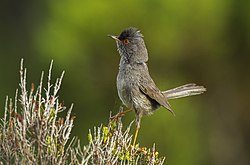| Marmora's warbler | |
|---|---|
 | |
| In Sardinia | |
| Scientific classification | |
| Kingdom: | Animalia |
| Phylum: | Chordata |
| Class: | Aves |
| Order: | Passeriformes |
| Family: | Sylviidae |
| Genus: | Curruca |
| Species: | C. sarda |
| Binomial name | |
| Curruca sarda (Temminck, 1820) | |
| Synonyms | |
Sylvia sarda (protonym) | |

Marmora's warbler (Curruca sarda) is a species of passerine bird in the Sylviidae family. The specific sarda is a Latin feminine form for a person from Sardinia. [2]
